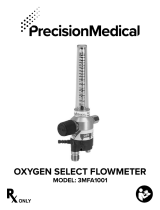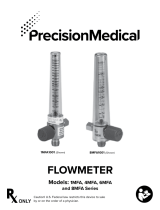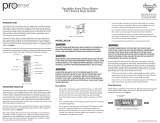
REPLACEMENT PARTS
Under proper care, there should be no need to stock replacement parts. Otherwise,
parts only need to be replaced if damaged. Any visible damage to the entire
surface of the O-ring or sight tube (particularly from the bottom edge) indicates
need for replacement. To insure accuracy, the inside surface of the meter core
tube, slot edges, and OD of the float piston should be free of nicks, chips, with no
visible erosion of any surfaces.
STORAGE REQUIREMENTS
There are no special requirements for Series P72 Flowmeters and parts. They
should be kept in a reasonably clean location away from excessive heat (over
120°F, 48ºC) or chemical or solvent fumes and vapors.
ASSEMBLY
Replace all parts in reverse order of disassembly. Note the small key on the core
tube that must be aligned with a corresponding keyway in the meter body. Seat the
O-ring on the sight tube before assembly (put the metal back-up ring on first for
glass sight tube models). Lubricate the O-ring with a small amount of service
compatible silicone grease or petroleum jelly to facilitate replacement.
After replacing the internals, using hands only, press the sight tube firmly down into
the meter body with a twisting motion. Be careful not to rock the sight tube side to
side and bend the snorkel tube/guide inward where it might interfere with float
movement. Rotate sight tube as necessary for scale visibility and/or alignment of
slots for lock ring tabs. Reinsert lock rings and cotter pins, lower flange and snap
ring (be sure snap ring engages groove in body), or flange bolts (do not over
tighten).
If reassembled correctly, the top edge of the indicator disk or center of the ball
should line up with the scale “zero” (either dotted black or scribed line). If it does
not, disassemble the meter completely and carefully reassemble it, making sure
core tube is completely seated in the body.
If new flow internals are used, the scale may have to be remounted on the sight
tube. Depending on the model type, this can be done either by loosening the
mounting screw, or reattaching the scale with double sided adhesive (new flow
internals are shipped with a new scale).
SYMPTOM
FLOAT HANG-UP
FLOAT BOUNCE
APPARENT FALSE
READINGS, GAS METERS
APPARENT FALSE
READINGS, LIQUID
METERS
APPARENT METER
READING MIGRATION
(reading changes but flow
appears constant)
LEAKAGE
USUAL CAUSE
Caused by particles, sludge, etc. (including failure to remove the
plastic tubing used to block meter float during shipment) inside the
core tube and/or sight tube holding float. A bent snorkel tube/guide
rod (usually caused by careless disassembly or violent surges) may
also be causing float to stick. Violent surges may also unseat the
internals in extreme cases.
Caused by pumping/compressor surges or other pulsation sources,
loose valve disks or similar mechanical components, extreme
violation of inlet piping recommendations, or for gas applications,
harmonics commonly found in systems with low pressure, low
density gas.
Gas density not according to calibration data (different pressure,
temperature, gas, etc.), high water vapor content, saturated gas
going into vapor or condensation phases, partially clogged core tube
slot or foreign matter interfering with float movement, and/or violation
of piping recommendations at high flow velocities.
Liquid density not according to calibration data (different temperature
or new liquid or liquid mixture), excessive dissolved or suspended
solids or gases, partial clogging of core tube slot or foreign matter
interfering with float movement, or viscosity levels above the meter's
immunity index (V.I.C.). Note: If the meter is suspected of giving false
readings, and none of the causes mentioned is found, please advise
as to the method used in determining the suspected flow “error.”
Each flowmeter is individually calibrated by traceable methods, and
carefully inspected. There may be some error in checking the meter
against another standard.
Frequently caused by use of soft disc type valves, which may need
to be replaced with a valve more suited to flow control. Can also be
indicative of changing fluid conditions (density, viscosity, etc.).
Problems with other elements of the flow system, including leaks,
clogged filters, pump/compressor wear, etc. may first appear as a
change in meter reading — one of the functions of a flowmeter.
If at the junction of the body and sight tube, it is indicative of either
(a) damaged O-ring (most common); (b) damaged sight tube; or (c)
damage to the gland section of the body. It may also be caused by
improper reassembly of the flowmeter in the field. If there is leakage
at the pipe connections to the meter, it is probably caused from over-
tightening pipes on a prior installation.
SUGGESTED REMEDY
Remedies include tapping the meter gently to temporarily dislodge the
float, but if problem reoccurs, meter should be disassembled & cleaned,
and/or snorkel/guide rod straightened. If hang-up caused by sludge or
pipe scale, clean lines and install a filter or other form of cleaner in supply
line. If surges have caused the internals to unseat, install a de-surger,
accumulator, etc. You may also wish to order a buffer kit — the buffer
serves as a resilient cushion for the float, and prevents unseating.
Modification of piping, such as addition of a de-surger, receiver,
accumulator, vibration eliminators, loops, hoses, etc. between the source
and meter should remedy the problem. Severe vibration may ultimately
damage the meter, and should be avoided. If "bounce" seems to be from
some other source, or shocks such as "water hammer" (a potentially
dangerous condition), discontinue using the meter and contact factory.
Remedies include checking meter pressure & temperature, determining
actual gas mixture density and correcting with appropriate formulae in
this bulletin. Modifying inlet piping, relocating meter to point of higher
temperature and/or lower pressure to eliminate vapor or condensation
phase effects, and/or cleaning the meter (install filter or other form of
cleaner if dirt repetitive problem) may also be required. If accuracy still
questioned, return core tube/float assembly for calibration check.
By determining the actual density (due to changes in mixture,
temperature, etc.), the correction formula may be applied. If dissolved
gases are in the liquid, some elimination means should be provided on
the supply side (also recheck all piping, as improper seals at connection
points are common sources of air in the liquid). If the metered liquid is
near the boiling point producing partial "flash gas" at the meter, relocate
the meter to point of lower temperature and/or higher pressure, or cool
lines and/or increase system pressure. Note: It is potentially dangerous
to meter near the "flash point" of any fluid, and this practice should be
avoided. Consult the factory for recommendations. The previous
recommendations regarding cleaning the meter and/or filtration will also
solve problems due to dirt. If metering liquids with high viscosities,
consult the factory (may require special calibration). If none of these
causes seem to be present, return meter core tube/float assembly along
with application data.
Verifying the proper fluid conditions are known and applying correction
formulae as needed will remedy problems associated with changing
fluids. Cleaning, servicing, and replacement and/or repair of other system
components may be required.
Replace any damaged parts immediately; using the proper assembly
procedures indicated in this instruction and the assembly detail drawings.
Remove the body and inspect for damage — if none is visible, check pipe
threads, reapply proper thread lubricant/sealant, and reinstall. If leak
persists, replace meter body.
TROUBLESHOOTING
Note: All Series P72 Flowmeters are hydrostatically pressure tested before they are shipped. Dwyer Instruments, Inc. encourages you to contact the
factory with any questions regarding proper installation and operation of Series P72 Flowmeters.
F-P72:TEMPLATE 8/19/10 12:11 PM Page 5









